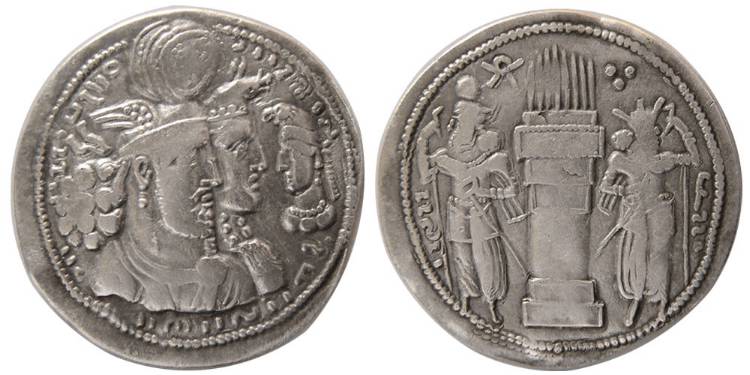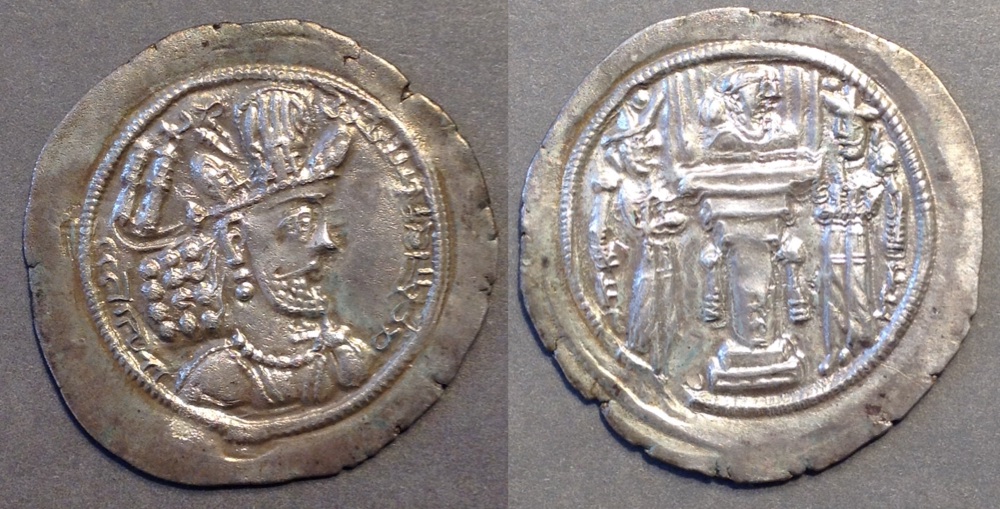 The Sasanian King Bahram II, 276-293.
The Sasanian King Bahram II, 276-293.
The Sasanian "King of Kings" Bahram II has his name spelled in various ways in English, including "Varhran" and "Wahram." He was young when he came to the throne (perhaps aged 14) as the son of Bahram I, grandson of Shapur I, and great-grandson of the founder of the Sasanian dynasty, Ardashir I. His claim to the throne was disputed by his brother Hormizd I (Hormazd) and by his uncle Narses (Narseh), who settled for becoming governor of Armenia and later reigned from 293 to 302.
The reign of Bahram II overlapped the reigns of the Roman emperors Probus through Diocletian. Most famously, Roman emperor Carus took advantage of the Sasanian civil war between Bahram II and Hormizd (in the east, the Kushan part of the empire) to invade the empire from the west in 283 and even capture, momentarily, the capitol, Ctesiphon, before heading for home. Carus died along the way and then his heir Numerian also died along the way which was too much to be a coincidence. Diocletian accused the Praetorian Prefect Arrius Aper of murder, had him executed, and was acclaimed Augustus. Then Diocletian arranged peace with the Sasanians under Bahram II. Historians do not record how Bahram II died.
This coin. Drachm. 29 mm. 4.30 grams. 3:00 die axis.
Obverse: Jugate busts right of Bahram II and a female, facing a small bust left.
Bahram II is wearing a cap with wing, diadem, and globe. He has a tied beard, large ball of curly hair, moustache, earring, and elaborate necklace. Behind him the female bust right has long hair and is wearing a hat with a boar protome. In front of them, the small bust left is beardless and wearing a hat with earflap, diadem, and bird protome. Some (e.g. Sellwood) attribute the female as the goddess Anahita and the small figure as Mithra. Others (Göbl) think it is the queen and crown prince.
Reverse: Fire altar and attendants, plain column, armed attendants learning on long staff, looking away from altar.
Identification numbers: Sellwood "Vahran II, type IV," page 90.
Göbl 59, "Vahran II," page 76 and plate 4.
Curtis, 59-60, plates 4-5.
Amini 230.
The coins. Bahram II's coins come in four major types:
I) king alone in right profile,
II) the king right, facing a smaller bust left,
III) the king and a woman jugate right, and
IV) the king and a woman jugate right, facing a smaller bust left (illustrated above).
"Type IV" is the most common type. It comes with four varieties of headdress for the woman (boar, horse, eagle, or griffin).
Bahram II was succeeded by his son, Bahram III (The rare coins formerly attributed to Bahram III have been reattributed to Narses, according to Karlsson). Barham III lasted only four months before being overthrown by Narses who was governor of Armenia and who had been a rival of Bahram II when Bahram II first came to the throne. Narses went on to defeat Galerius who invaded along the plains in 295, but Galerius returned in 296 with a new strategy of invading through the northern hills. Narses was routed and Rome retook the region of Nisibis and Sinjara. The frontier between Rome and the Sasanian Empire moved east to the Tigris.
Of course, this new border was not final. However, armed conflict between Rome and the Sasanian Empire paused until 337 when Nisibis and Sinjara were beseiged by Shapur II (image below), but they were not taken because an invasion from the east required the recall of the army. However, when war with Rome resumed in 359, Nisibis and Sinjara were taken after a brutal seige. Constantius II prepared to retake them but was overthrown by Julian II first. Julian II took up the task but was killed in 363 during his invasion of the Sasanian Empire which was still ruled by Shapur II who reigned a remarkable 70 years.
 Shapur II, 309-379
Shapur II, 309-379
Drachm. 30 mm. 4.14 grams.
His bust right with a distinctive crown.
Fire altar and attendants, with bust right in the flames.
Sellwood 32. Göbl 102. Amini 373. Karlsson D13.
Conflict with Rome continued on and off until the Arabs conquered the Sasanian Empire in the 600's.
The End
References.
Amini, Amin. Sassanian Coins. [This book has 950 images of quality coins. It is in Farsi with almost no English except for the king's name labeling groups of coin photos. This book spells the name "Bahram."]
Curtis, Vesta Sarkhosh, M. Alehe Askari, and Elizebeth J. Pendleton, with Richard Hodges and Ali-Akbar Safi. Sasanian Coins: A Sylloge of the Sasanian Coins in the National Museum of Iran (Muzeh Melli Iran), Tehran. Volume 1. 2010. [A sylloge, so no explanatory text, but extensive descriptions of the types, in English.] This book spells the name "Bahram."
Farrokh, Kaveh. Shadows in the Desert: Ancient Persia at War. 2007. [Not a coin book. This book spells the name "Bahram."]
Göbl, Robert. Sasanian Numismatics. 1971. [A commonly-available book on Sasanian coins, difficult to undertand, but with enough photos to attribute coins.] This book spells the name "Vahran."
Karlsson, Yngve. Sasanaian Silver Coins. 2015. An introductory coin book with a short discussion of each reign and many useful line drawings of legends for identifying mints, regnal years, etc., and 200 color coin photos. This book spells the name "Wahram."
Sellwood, David, P.W. Whitting, and R. Williams. An Introduction to Sasanian Coins. 1985. [The usual introduction to Sasanian coins.] This book spells the name "Vahran."
wikipedia under "Bahram II" https://en.wikipedia.org/wiki/Bahram_II
Go to the main Table of Contents page of this whole web site.
 The Sasanian King Bahram II, 276-293.
The Sasanian King Bahram II, 276-293.  Shapur II, 309-379
Shapur II, 309-379